Measuring Solution Features
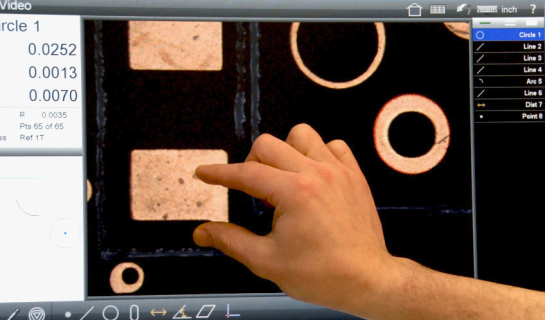
Features & Benefits
• Designed for Multi-Touch software control. In addition to the conventional mouse interface, expanded Multi-Touch logic allows for one-touch feature measurements as well as versatile pan and zoom of the live video image and the active part view. Increase the efficiency of feature measurements, feature data manipulation, and reporting tasks with a simple pinch zoom, swipe pan, or double click.
Feature measurements may be performed using common touchscreen operations such as pan and pinch zoom. Or use conventional mouse operations like point and click.
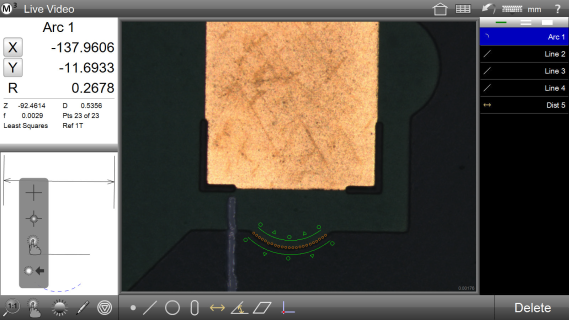
Advanced video probe toolbox.
The custom EyeMeasure™ probe captures complex edges by creating a custom “tool zone” according to the finger path drawn on your touch
screen enabled system. The MeasureLogic™ probe’s intelligent design provides an instant feature determination and measurement with
a single click or press. The Vtouch™ probe provides industry first video touch probe functionality, with simple acquisition of individual
points on a feature’s edge, just a single press or click away. The simple DXF Crosshair tool is
always available for manual crosshair probing and can be translated or rotated within the video image for flexible manual probe measurements.
Complex edges are no problem for your M3 software. You have options for probing including our
exclusive MeasureLogic and Vtouch probes.
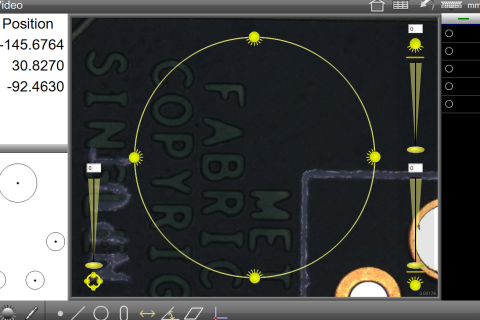
Support up to 8 channels of programmable light
control.
On-screen controls let you adjust Coaxial, Substage, and Quadrant Ring light output accommodating a wide range of measuring requirements. Your light levels are also remembered and may be recalled for program playback.
On-screen controls let you adjust your light output.
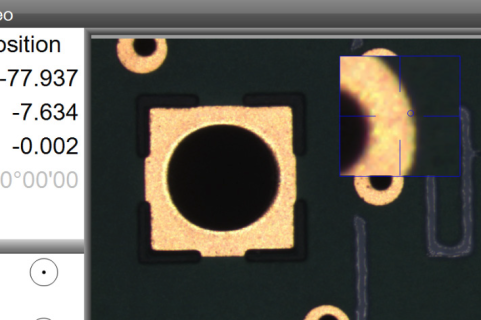
Advanced Edge Teach.
Improve edge detection performance under a variety of image and
lighting conditions. Features with poor edge contrast, or difficult
spacing can be captured in a snap using the M3’s manual teach
function. Press and hold on an edge in any video image to specify
a teach region.
On-screen controls let you adjust your light output.
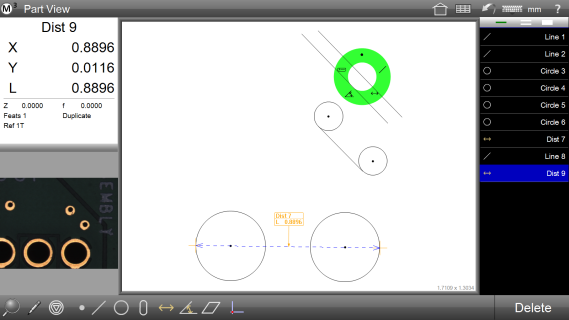
Graphics-based “Part View” constructions.
Generate popular construction types, like Distances and Tangent Lines, from within the graphical part view itself. The “Gesture Menu” can be used within the part view to provide access to “on the fly” feature creation and manipulation tools.
Supported construction types include:
* Average * Mid/Center Point(s) * End Point(s)
* Intersections * Shortest Distance * Farthest Distance
* Tangent Line(s) * Gage Circle(s) * Bolt Circle
* Angle Compliments * Perpendicular/Parallel Line(s)
* Offset Skew Lines
Features with poor edge contrast or difficult spacing can be captured easily with
the M3 software’s manual teach feature.
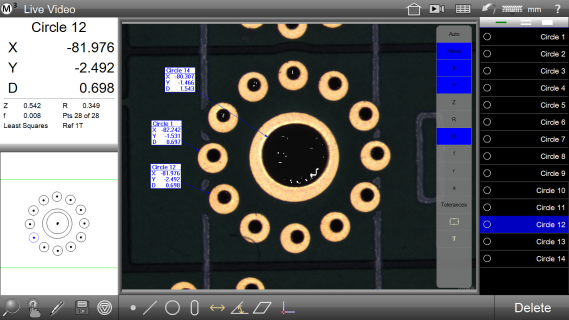
Quick Annotate and Markup.
Gain access to instant feature markup tools using the part view “Gesture Menu”. Add customized feature data to your live video image or part view displaying only the desired coefficients. You
may annotate one or several features simultaneously with the smart marquee feature selection.
Use the Gesture menu to access on-demand feature create and manipulation
tools.
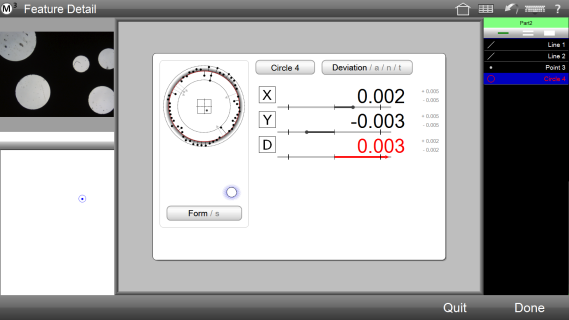
Geometric Tolerancing.
Measure features, set nominals, apply tolerances and view deviation results with only a few quick clicks. You may also apply a variety of popular tolerance types to features in the standard
“feature-to-feature” fashion, or utilize the “place tolerancing” system for applications where tolerances are specified in a block tolerance style call out. For these cases the M3 software let’s you
enter and apply universal tolerance values according to your feature resolution groupings.
Add customized feature data to your live video image or part view.
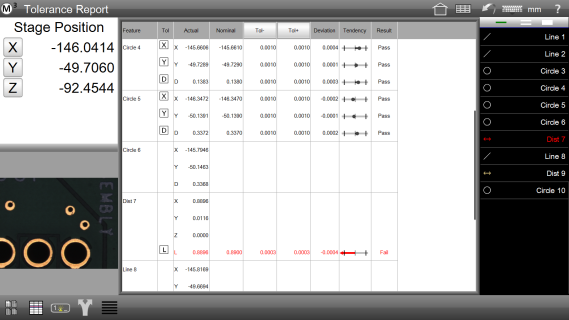
Supported tolerances include:
* X/Y/Z Positional
* Diameter/Radius/Length/Width Size
* Theta (Angle)
* Form
* Parallelism
* Angularity
* True Position (LMC/MMC Modifiers)
* Straightness
* Perpendicularity
* Roundness
* Concentricity
* Runout
(Top) Measure features, set nominals, apply tolerances and view deviation
results quickly and easily.
(Bottom) Display your comprehensive tolerance report.

Feature Detail Graphics.
Individual feature views provide you with informative drawings displaying point cloud distributions, as well as nominal deviations,
and tolerance results. Scroll through your measured features list from this view for a feature by feature display of Actual, Nominal, Tolerance, Deviation, and Data Fit Type information.
Individual feature views provide you with informative drawings with point cloud
distributions, nominal deviations and tolerance results.
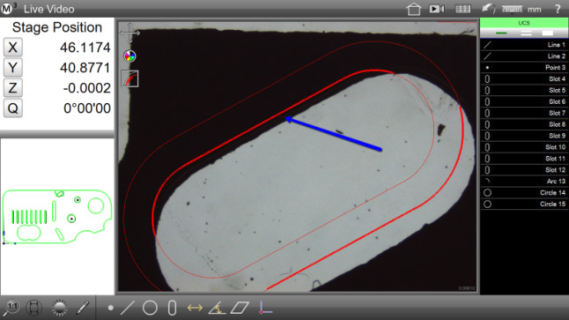
DXF Overlay and FOV capability.
Using the DFX/FOVE option pack, you may import DXF files for “comparative style” Go/No-Go feature and part inspection. This includes a live error whisker display for part violations of the
original DXF tolerance zones. You may even utilize custom DXF crosshair files, create “on the fly” overlay feature tools, and utilize pattern recognition for part program playback.
DFX/FOV option pack features include:
* Custom DFX crosshair
* Create feature-based video overlays
* Import DFX overlay
* Export features to DFX
* Pattern teach and recognition
* Live image “freeze”
Import DFX files for Go/No-Go feature and part inspections.
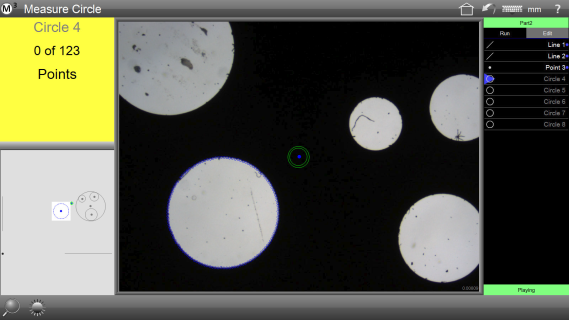
Part programs and playback.
Playback or edit groups of measured, constructed, and created features from your saved part program file. Part program files,
when loaded, will prepare the M3 software to repeat a sequence of feature measurement steps, printed reports, and exported measurement data. The playback guidance mechanism features
helpful on-screen instruction for successful playback of your part programs.
Playback or edit groups of measured, constructed and created features.

Flexible Report Content and Formatting.
M3 software supports full customization of the data format, header information, and header and footer graphics. Part view graphics, time and date stamps, and operator information can all be included for any report type.
Reports can be viewed, printed, or exported at the conclusion of a single inspection routine, or they can be included in a part program
to support repetitive or automated measurement and reporting. Reports may be printed directly to a local or networked, Windows-compatible
printer. Reports may also be exported as a text or .csv file to local or network storage locations.
Report data formats include:
* Standard Report
* Tolerance
* CSV
* European
View, print and export report data at the conclusion of your inspection routine.
MetLogix M Series Features Matrix

